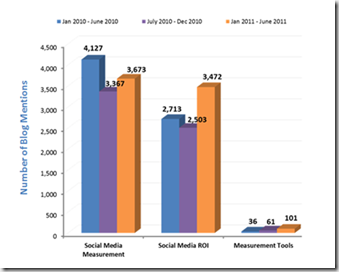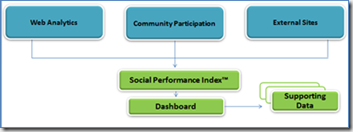Recently, the ComBlu team conducted a deep dive on the state of measurement in our industry. We looked back at online conversations over the last 18 months to glean any insights into the maturity and growth of social media measurement. No big surprises—the discipline is coming along slowly, but surely.
Just a year ago, the conversations centered on the “what” and the topic of social media measurement in general. What do I measure, and is this really actionable? Six months later, we arrive at the “how.” Conversation volume decreases slightly, but the sophistication level goes up. How do I track and manage data from multiple platforms? I have more data than I know what to do with. How do I define ROI? Today, the conversation is in the “why” phase. Clearly, ROI has always been front and center of the measurement landscape, but now it’s as an equal. It’s time to ask the hard question—are we getting what we paid for?

While there is no big “aha” found in the data points above, it validates what my clients, colleagues and partners are saying—this is “the year of ROI.” But, the deliberator in me wants to back up and assess the current situation. Measurement tools barely represent a fraction of the conversation, which is really the “how,” and I am not certain that we have cleared that hurdle yet. I challenge anyone to demonstrate ROI of their social program if they don’t know how or have the right tool set in place to measure engagement.
Engagement is the driver behind any social program and there are multiple flavors of it. We don’t engage just for fun—we do so because it is intended to impact the business favorably. In order to track engagement, we must start with the right mix of metrics. It’s true that metrics do not equal ROI, but an engaged stakeholder base does. Below are some common social health and performance metrics to consider as you build out your engagement strategy:

As you can see, engagement is not measured by the number of Facebook fans, Twitter followers or your community members. Engagement is about achieving a desired outcome that is based solely on the objectives of your organization.
Let’s walk through a scenario. Brand X is planning for the limited pre-release of their new 4G smart phone, so they develop an advocacy program to support it. The brand knows that online user-generated content (UGC) impacts sales because 70 percent of consumers trust the recommendations of others, even if they don’t know them personally. Pretty simple stuff. Below is the construct:
|
KPI |
Desired Outcomes |
Metrics |
| Increase online product recommendations by 45 percent | Engage brand advocates for the creation of user-generated content (UGC) via:· Product reviews· Customer stories· Videos· User ratings | · # of product reviews on owned assets· # of third party product reviews · # of product reviews on retail partner sites· Average rating of 4· # of videos uploaded· # of views
· # of comments · # of shares |
Brand X invested in an integrated social platform dedicated to mobile technology as a means to engage their customers. In turn, those customers generated tons and tons of content that lives on Brand X’s owned assets and other third party sites, such as YouTube, Amazon and Best Buy. These customers spent much of their personal time thoroughly testing and reviewing the product from soup to nuts. Then, they amplified their opinions on highly influential sites. Here is a small sample of the results:
· Member video on YouTube generated more than 25,000 views, plus positive comments relating to purchase intent
· Member review on Amazon generated 75 “helpfuls” in the first week
· Member forum post on Best Buy’s online community generated 250 views and sparked conversation
A healthy and performing social program does equal ROI because it indicates whether or not you are engaging successfully. For Brand X’s model to be successful, they needed the ability to track:
· Incoming traffic to the platform
· Membership growth
· Return visits and login activity
· Content consumption patterns
· Content creation, rating and sharing—both on- and off-domain
· Feedback received

By having the ability to pinpoint what engagement tactics were working and which ones had little traction, Brand X was able to diagnose member behaviors and trend from a red status to a green one. They:
· Made adjustments to content and its placement
· Interacted directly with their most prolific members and thanked them on a regular basis
· Developed return motivators to ensure frequent participation
· Modified the user experience and navigation based on direct feedback
· Asked more relevant and meaningful questions of the membership base and communicated back to them
· Syndicated and showcased UGC on their owned assets
Utilizing a diagnostic tool provided Brand X with actionable information. They made adjustments and course corrections when needed. By meeting the needs of their customers through engagement, they were able to increase their online recommendations above goal. This is why social health and performance matter. Brand X could tell a complete story and answer the “what,” “how” and “why.”
As social media measurement continues to mature as a discipline, the “how” should become clear and the available toolset should follow the curve. It will be interesting to see the capabilities and new technologies that emerge over the next six months. To continue this conversation, you can meet up with Kathy Baughman, who will be speaking at WOMMA’s Talkable Brands Exchange in August.

Senior Consultant
Jenny is a digital content strategist, who leads customer-centric engagements that focus on understanding B2B buying behaviors and developing custom roadmaps.
Her expertise is creating buyer personas and mapping digital content journeys to assess the multi-channel user experience. She helps clients operationalize plans across workstreams and identifies processes to create efficiencies in marketing operations. Jenny also has extensive time under her belt developing and managing customer advocacy programs and community building.
She has helped a diverse group of organizations including Cisco, VMware, Verizon, Microsoft, Dell, BMO Harris, Capital One and many others become more customer-centric.
